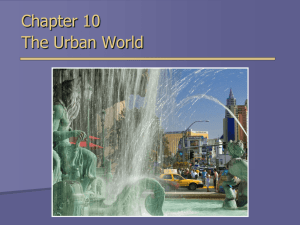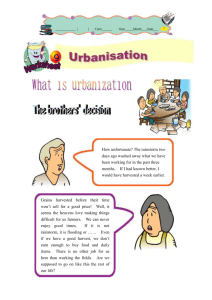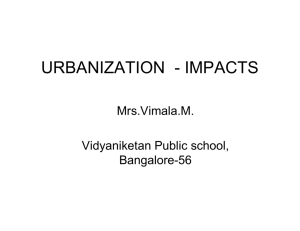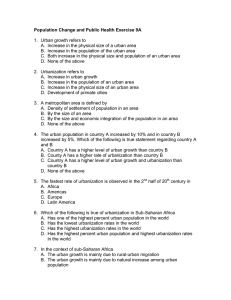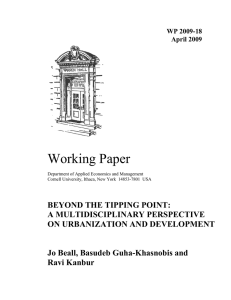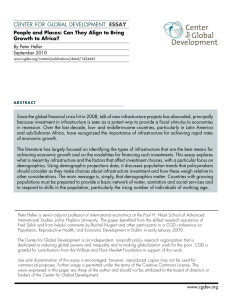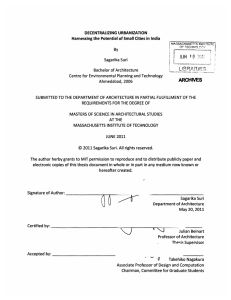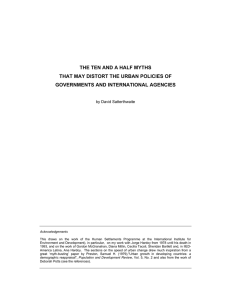5-urbanization and environment
advertisement
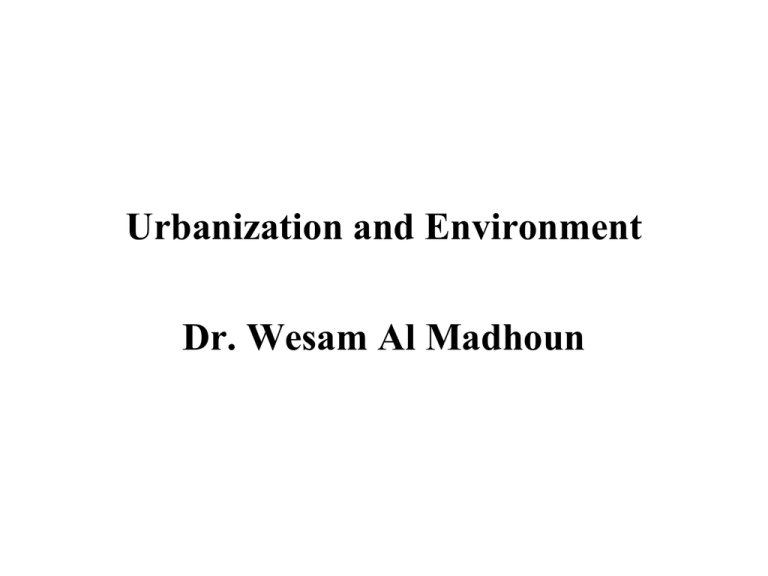
Urbanization and Environment Dr. Wesam Al Madhoun Important issues • • • • • How cities have changed and why Rural, urban, and suburban living Globalization and urbanization Population growth and its consequences Globalization, urbanization, growth, and the environment 2 Ancient cities • Organized very differently than today’s cities, both spatially and socially • Centers for culture, science, commerce, and so on • The vast majority of the population lived in rural towns and communities, with little or no connection to cities. 3 What is urbanization? • Urbanization is a shift in population from rural living to living in cities and towns. • Occurred alongside industrialization. • London as a prime example: – 1800: 1.1 million people – 1900: > 7 million people • The United States: 1800: <10% urban 2010: approximately 80% urban 4 Global urbanization • 1900 onward: urbanization became a global, not just national, process. • That trend intensified from 1950 forward. • Global, urban population statistics: – 1975: 39% – 2000: approximately 50% – 2050: estimated 70% 5 Rural life • Rural areas = 75% of land, but hold only 17% of the population. • The rural population has been in decline for most of the twentieth century. 6 Declining rural population • • • • • Declines in farming and other rural industries High poverty rates Few opportunities or amenities Few government services Hard to attract new residents • New technologies and social programs work to reverse these trends 7 Suburban development • Suburbs are towns that develop as residential hubs around industrial cities. • Suburbs developed during the economic boom that followed World War II. • This happened with significant government assistance. • Suburban populations have been largely white. 8 Problems with urban life • Suburbanization led to changes in cities. • Industries left cities, taking mostly blue-collar jobs with them. • This led to increased residential segregation as poorer remained in cities. • This left cities with lower tax revenues, leading to perpetual financial problems. 9 Urban renewal • Gentrification is a process whereby wealthy people buy and renew deteriorating properties in cities. • Tends to be good for property values but bad for the previous, low-income residents. 10 Global cities • Global cities are those that house major transnational corporations and other global firms. • These are the seats of global power and control. • Global cities are sites of extreme wealth and poverty. 11 Urbanization in the developing world • Africa and Asia are still predominantly rural— only around 40% urban. • The urban population is growing more rapidly in these regions of the world. 12 Urbanization in the developing world • Major environmental risks are posed by such rapid growth, overcrowding, and poverty: – Housing – Pollution – Sanitation – Water supply 13 Studying global populations • • The study of population is called demography. Important terminology: – – – – Crude birthrate Fertility and fecundity Crude death rate (mortality) Life expectancy and life span 14 Map 15.1 Population Growth Rate, 1980–2002 Essentials Of Sociology, 3rd Edition Copyright © 2011 W.W. Norton & Company Consequences of population change • Rapid population growth and urbanization may lead to: – – – – – – Increased internal migration Significant environmental challenges Health concerns Increased crime More and larger squatter settlements Famine and food shortages 16 The environment and society • The way of life in Western societies creates major environmental challenges. – Massive amounts of non-recyclable waste – Pollution – Depletion of resources and biodiversity 17 The environment and society • Global warming—also a human product— affects us all. • Energy consumption may outstrip certain resources. 18 Figure 15.2 Shares of Total World Consumption of the Richest 20 Percent and the Poorest 20 Percent, 1995 Essentials Of Sociology, 3rd Edition Copyright © 2011 W.W. Norton & Company Sustainable development and change • New sustainable development policies seek equilibrium between environmental concerns and the economy. • Such policies tend to work well for wealthy countries at the expense of poorer countries. 20


